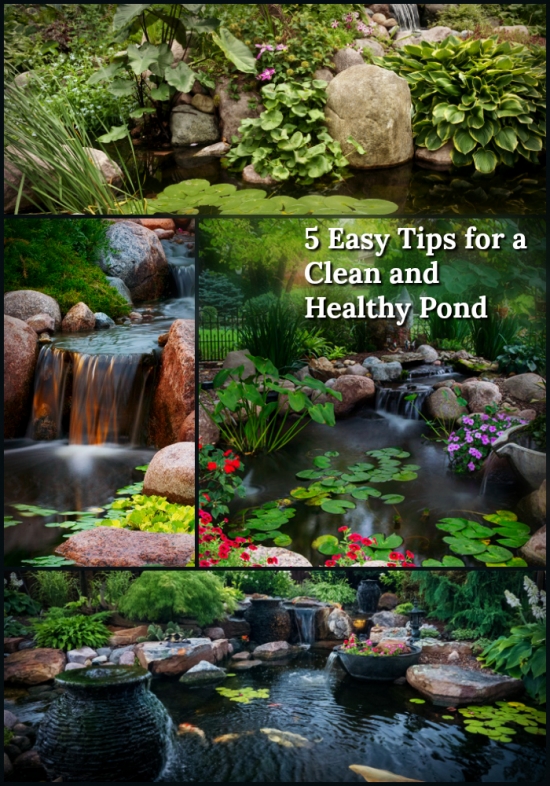Pond Maintenance: 5 Steps for Success
- 03
- 04
- 2021
- Category:
- Uncategorized

What is a pond and why do you need pond maintenance? Your pond is a beautiful ecosystem to a host of living things, and you want to ensure that the habitat is healthy for the sake of both your fish and plants. Not to mention, a healthy pond with clean water is so much prettier to look at than a murky water garden.
One of the most important parts of a pond habitat is good quality water. Not knowing how to get good water quality or keep it is one of the hardest parts of being a pond owner. But don’t worry—what follows are five tips for pond maintenance.
1. A Balance of Filtration
A good biological filtration system, paired with a mechanical filter (such as a skimmer) to remove solids before the water enters the biological filtration unit, is the most effective way to filter water. Designing and implementing an efficient circulation and filtration system ensures that the water is oxygenated and pond debris (including leaves, floating algae, and anything else that’s blown in) will be swept from the pond’s surface and deposited into an easily emptied skimmer basket.
2. The Right Pump for Your Pond
Pumps are the heart of any water feature, continually circulating water and providing aeration to create the basis for a stable ecosystem. Proper pump sizing is critical to the health and function of your water feature and you want to be sure you’ve selected the correct pump.
To provide optimal water quality, you want to circulate the entire pond’s water volume a minimum of once every hour. If your pond contains 1,000 gallons of water, you need a pump that will push a minimum of 1,000 gallons per hour. Other variables come into play when choosing the proper pump, like the height of your waterfall and the length of pipe that runs from your pump to the waterfall.
3. Maintain a Healthy Fish Population
Pond owners love their fish and it’s easy to over-populate your pond – especially if your fish have babies! Make sure you have no more than 10” of fish for every 100 gallons of water in your pond. You want to avoid excessive fish waste, which can cause an unhealthy imbalance in pond water. As an important part of pond maintenance ,if you find yourself with an abundance of fish, consider finding a new home for some of your finned friends. Pond retailers and contractors might be willing to accept your fish. You can also contact local koi clubs.
Calculate How Much Water Is In Your Pond: Length x Width x Average Depth x 7.48 = U.S. Gallons*
*Length, width, and depth are measured in feet
One of the many joys of pond ownership is interacting with your fish. Many people train their koi to eat straight from their hand! However, when you feed fish more than they can eat, the uneaten food is left to decay in the pond. This can prove problematic to the quality of your pond water. Be careful not to feed your fish more than once per day, and no more than they can eat in two to three minutes. Remove all excess, leftover food so it doesn’t deteriorate in your pond.
4. Create a Proper Balance of Plants
Plants are an important part of pond maintenance. Plants absorb excess nutrients in the pond and help filter the water. In addition, plants like waterlilies and water lettuce help to shade the pond and keep the water cooler during hot summer months. During the peak pond season, you want to ensure that 40% to 60% of the surface area of your pond is covered or shaded by plants. On the flip side, too many plants can cause oxygen deficiencies at night due to the photosynthetic process, when the plants take in oxygen and give off carbon dioxide.
You’ll enjoy the beauty provided by a wide range of pond plants, which fall into four basic categories.
Waterlilies are a favorite for the beautiful color they add to a pond. Hardy lilies return every year if properly over-wintered. Tropical waterlilies will die during winter months in most climates and are typically treated like annuals. Marginal plants thrive in shallow water near the edges of the pond. They include both flowering and non-flowering options and help to soften rock edges while providing filtration benefits. Floating plants such as water lettuce and water hyacinth, float on the surface of the pond with their roots dangling in the water. Finally, oxygenators are planted at the bottom of the pond and help provide hiding places for fish.
5. Pond Maintenance: Clean Debris from Pond Before It Decays
Decaying leaves and debris, combined with fish waste and leftover fish food, can cause ammonia levels to spike in your pond. High ammonia levels can stress your fish and cause illness. Be sure to remove dying leaves and plants, and remove uneaten fish food before it has a chance to decay. During the summer months, you shouldn’t find a lot of leaves and plant debris in your pond, but be sure to trim any dying leaves from aquatic plants.
Enjoy Your Best Pond Ever with Proper Pond Maintenance
Following the above guidelines helps ensure that your pond is naturally balanced, thereby requiring less maintenance. When water in a pond is murky and unattractive, it’s usually due to one (or more) of the previous tips not being followed. You’ll be surprised how easy it can be to enjoy clean and clear pond water throughout the season. And less work, means more time you get to spend enjoying your beautiful water garden!
